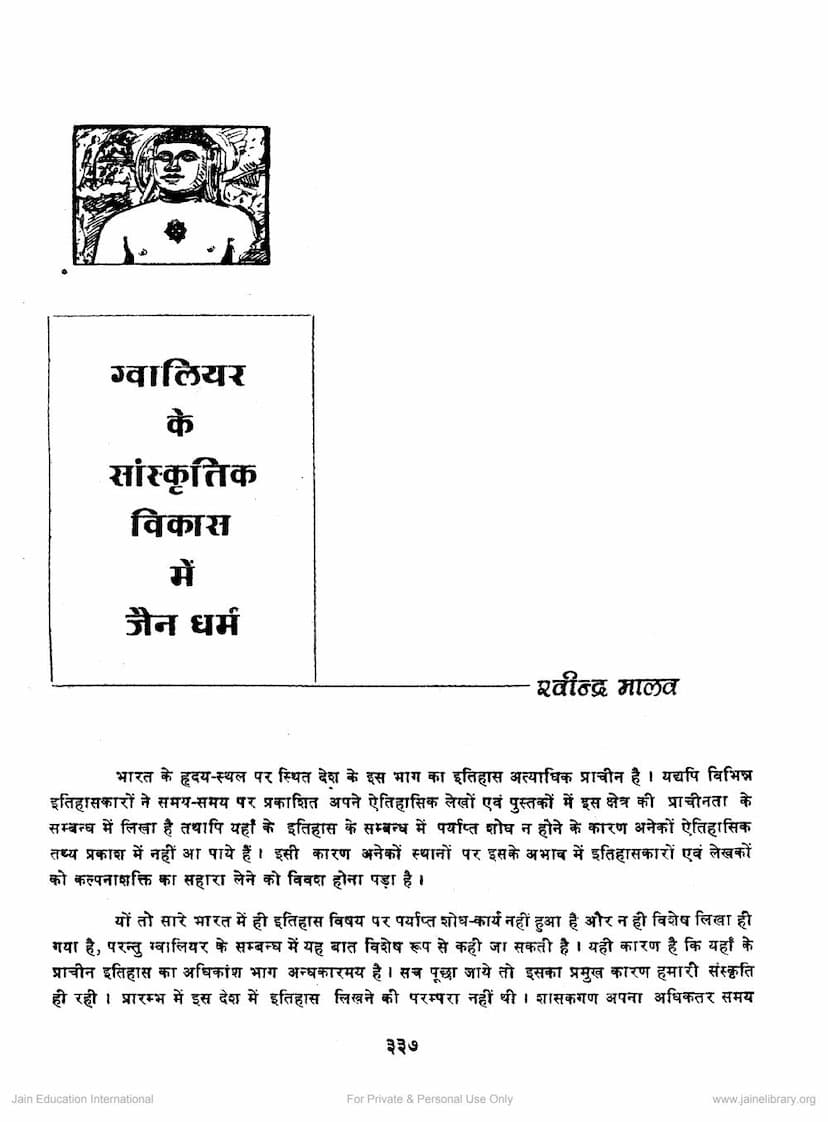Gwalior Ke Sanskrutik Vikas Me Jain Dham
Added to library: September 1, 2025

Summary
Here's a comprehensive summary of the Jain text "Gwalior ke Sanskrutik Vikas me Jain Dham" by Ravindra Malav, focusing on the cultural development of Jainism in Gwalior:
The book explores the rich and ancient history of Jainism in Gwalior, highlighting its significant contribution to the region's cultural development. The author emphasizes that while the history of India, and specifically Gwalior, is very ancient, a lack of extensive research has left many historical facts in the dark.
Early History and Inscriptions:
- The text traces the origins of Jain presence in Gwalior back to its very inception as a city.
- Early historical evidence comes from inscriptions, with a particular mention of a Huna inscription dating to 515 CE, hinting at the presence of Jain followers during that period, though detailed information about their status is scarce.
- The author notes the absence of a strong tradition of historical writing in ancient India, with most early writings focusing on rulers or religious texts.
- The presence of Jain monks and their practices is mentioned, with a reference to the Chinese traveler Xuanzang's account of "Nirgrantha" (naked) ascetics.
Jainism in the Gupta and Post-Gupta Periods:
- Two rock-cut Jain sculptures from the late Gupta period are discussed, one depicting a Tirthankara in Kayotsarga mudra and another in Padmasana mudra. These sculptures show influences of Gupta-era art.
- By the 8th century CE, the text indicates a systematic development of Jainism in the region, then known as Gopachal.
- The adoption of Jainism by King Am of Kannauj (son of Yashovarman) and his patronage of Jainism is highlighted. Am is credited with building Jain temples and installing Jain idols, including a large idol of Tirthankara Mahavir in Gwalior. It is suggested that this "Am" might have been Nagabhatta II of the Pratihara dynasty.
- Sculptures of Ambika Yakshi and Gomeda Yaksha from the 8th century are noted for their artistic merit and similarity to Kushan and Gupta period art.
Medieval Period and the Rise of Jain Influence:
- The 9th and 10th centuries saw the presence of independent Jain idols in Gwalior Fort, including those of Adinath and Parshvanath.
- The construction of the Sas-Bahu temple during the 10th century is mentioned, with its inscription revealing the continued prominence of the Jain community during the reign of the Kachhapaghatas.
- King Bhojadeva of Kannauj is also mentioned as having ruled over Gwalior Fort, with evidence from inscriptions from the Chaturbhuj temple.
- The 10th and 11th centuries were a period of significant Jain artistic activity, with the creation of a copper "Chaitya" (temple) and four Tirthankara copper images. The Nandi-shwar Chaitya, a unique architectural piece, is described in detail.
- The text highlights the presence of prominent Jain ascetics and scholars during this era, with mentions of Mahacharya Shri Devsen and their influence on artistic and literary works.
- Jain monasteries and educational centers (Vidyapeeths) were active, with Jain merchant guilds (Sanghas) also flourishing.
- The Tomar dynasty's rule over Gwalior saw a considerable patronage of Jainism. King Veerammadeva's reign is particularly noted, with the construction of a large Jain temple for Chandraprabhu by his minister Kushraj.
- The influence of Jain scholars is seen in the literary works of the period, with several important Jain texts being commissioned and copied. The flourishing of Jain literature during the Tomar period is a significant theme.
Later Medieval Period and Decline of Jain Patronage:
- The text details the reigns of subsequent Tomar rulers like Ganapatideva, Dungarsingh, and Kirtisingh, all of whom had a strong connection to Jainism.
- King Dungarsingh is credited with expanding the kingdom and promoting Jain arts and literature. The construction of victory pillars and the carving of numerous Jain statues in the Gwalior Fort are attributed to his patronage and that of his son Kirtisingh.
- The period of King Mansingh is also significant for its patronage of arts and music, although the text notes a decline in the patronage of Jain literary figures during his reign.
- The invasion of Babur and the subsequent Mughal rule marked a turning point. Babur's account in the "Baburnama" describes his encounter with the Jain sculptures on Gwalior Fort, detailing their destruction and defacement. The text suggests that Babur's actions led to a significant decline in Jain artistic and cultural activities.
- The Mughal period saw the Gwalior Fort primarily used as a prison, with limited attention given to the city's development or the well-being of its original inhabitants.
- While temples were constructed during the Maratha period, the overall decline in the prominence of Jainism is evident.
Modern Period and Revival:
- The text touches upon the Maratha rule and the eventual British influence, noting the sporadic construction of Jain temples during this period.
- The establishment of the "Jati Ji ka Mandir" and other temples in Lashkar and Gwalior city are mentioned.
- The author notes the significant contribution of Jain merchants and patrons in the construction of temples and the preservation of Jain literature.
- The text concludes by emphasizing the enduring impact of Jainism on Gwalior's history, literature, and archaeology, while also highlighting the need for further research to uncover more of its hidden aspects.
In essence, the book "Gwalior ke Sanskrutik Vikas me Jain Dham" provides a detailed historical account of the deep-rooted presence and significant cultural contributions of Jainism in Gwalior, spanning from its early origins to the modern era. It showcases the artistic achievements, literary patronage, and socio-religious activities of the Jain community in shaping the cultural landscape of the region.